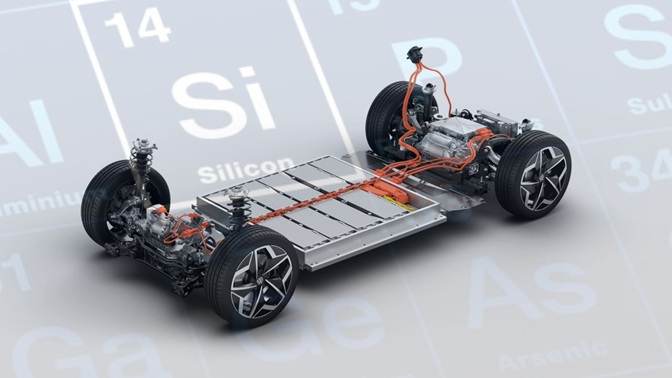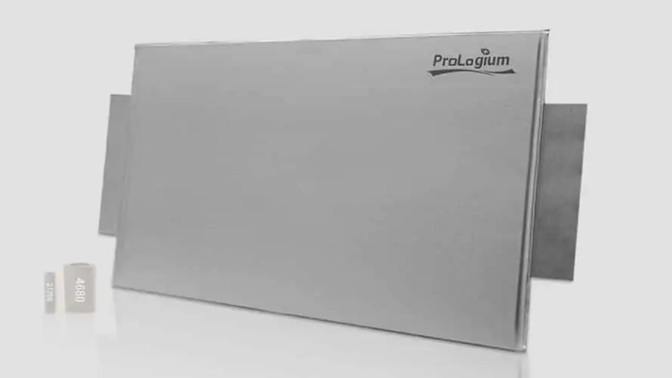The race to build smaller, more efficient, and longer-range EV batteries is heating up, and silicon anodes are emerging as one of the most promising advancements in battery technology. Currently, automakers and battery manufacturers are exploring various solutions to improve energy density, charge times, and overall efficiency. One of the biggest breakthroughs in this pursuit? The shift from traditional graphite anodes to silicon anodes.

According to George Cintra, General Motors’ battery R&D director, the “evolution toward silicon anodes is now starting.” He explains that silicon enhances EV range and improves fast charging, making it a critical innovation in the next generation of electric vehicle (EV) batteries. So, what exactly are silicon anodes, and why are they such a big deal?
In an EV battery, the anode is where lithium ions are stored when the battery is charged. Traditionally, most EV batteries use graphite-based anodes. However, this approach has its limitations:
- Graphite isn’t highly efficient – 50-70% of raw graphite gets wasted during production, making the process costly and inefficient.
- Energy storage capacity is limited – Graphite can only store a fixed amount of lithium, capping the battery’s performance.
- Charge speed constraints – EVs with graphite anodes take longer to charge, limiting fast-charging potential.
Silicon, on the other hand, offers multiple advantages:
- Higher Energy Density – Silicon anodes can store more lithium than graphite, leading to longer range per charge.
- Faster Charging – Batteries with silicon anodes can charge and discharge faster, making quick refueling a reality.
- Lighter Batteries – Silicon reduces overall battery weight, improving EV efficiency and performance.
If silicon anodes are so great, why aren’t they in every EV already? The main challenge is scaling up production.
- Manufacturing Complexity – Silicon anodes require specialized production processes that are slow and resource-intensive.
- Material Stability Issues – Silicon expands when charging, which can cause the battery to degrade faster over time.
- Higher Costs – Developing new battery technologies is expensive, and companies are still working on cost-effective solutions.
Despite these hurdles, battery manufacturers are making progress, and some have already achieved impressive results.

Companies Leading the Silicon Anode Revolution
Several battery companies and automakers are racing to commercialize silicon anodes. Let’s take a look at some of the key players:
1. ProLogium’s Breakthrough at the Paris Motor Show
Taiwanese startup ProLogium recently unveiled a 100% silicon composite anode that delivered an energy density of 321 Wh/kg—far above the industry average.
Impressive Performance:
🔹 A 55 kWh battery pack charged from 5% to 60% in just 5 minutes.
🔹 It reached 80% in only 8.5 minutes.
🔹 It could reduce an EV’s weight by hundreds of kilograms.
2. Sila Nanotechnologies’ Silicon Anodes in Mercedes-Benz EVs
Sila has already introduced silicon anodes in the electric Mercedes-Benz G-Class, though details are limited.
- The EPA range is 239 miles, and the EV can charge from 10% to 80% in 32 minutes on a 200 kW charger.
- Sila hasn’t disclosed how much silicon is used in the anode, but it’s likely a hybrid design rather than a 100% silicon anode.
3. GM’s Vision for the Future
General Motors is exploring silicon anodes for future EVs and aims to implement them by the end of the decade.
Why it matters for GM:
🔹 Current GM models like the Chevy Silverado EV and GMC Hummer EV have massive 200+ kWh batteries, making them heavy and inefficient.
🔹 In a real-world test, the GMC Sierra EV Denali achieved 506 miles of range, but with terrible efficiency (48.1 kWh per 100 miles or 2.0 miles per kWh).
🔹 Silicon anodes could help shrink battery sizes, reduce weight, and improve overall performance.
The shift to silicon anodes is already underway, but full-scale adoption will depend on solving production challenges and bringing costs down.
Here’s what we can expect in the coming years:
- Smaller, Lighter, and More Efficient EV Batteries – Silicon anodes will help shrink battery sizes while improving performance.
- Faster Charging Times – Newer battery chemistries will significantly reduce charging wait times.
- Lower Costs as Adoption Increases – As production scales up, prices will drop, making next-gen EVs more affordable.
George Cintra from GM remains optimistic, stating:
“As the new materials come on board, like silicon anodes and the new cathodes, the battery sizes will shrink. As volumes increase, the adoption rate will increase, and you will see prices come down.”
The EV industry is constantly evolving, and silicon anodes could be one of the biggest game-changers yet.
🔹 They offer higher energy density, faster charging, and reduced battery weight.
🔹 Leading companies like ProLogium, Sila Nanotechnologies, and GM are already making progress in commercializing the technology.
🔹 Challenges remain, but with continued innovation, silicon anodes could revolutionize EV batteries within the next decade.
So, will silicon anodes be the key to smaller, more efficient, and longer-range EVs? The answer is looking more and more like yes. What do you think? Are you excited about faster-charging, longer-range EVs powered by silicon anodes?
Related Post
